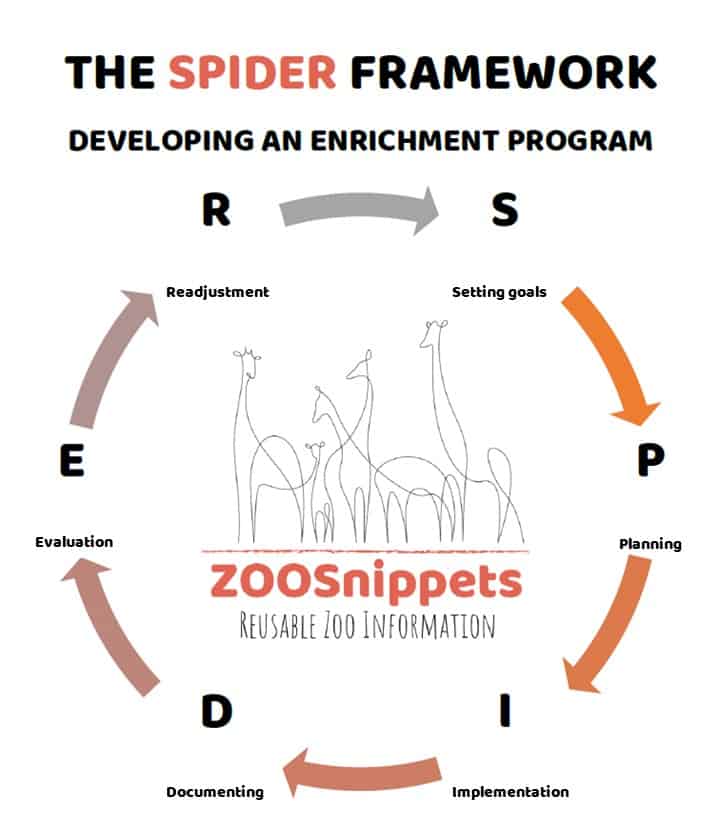To set up and maintain a well-thought animal behavioural enrichment program, you need a decent layout for such a program. The S.P.I.D.E.R. framework is a helpful tool to fulfil this. So let’s take a look at how the framework works and how to implement it in your zoo. The S.P.I.D.E.R. model allows institutions to set up, review, refine and modify environmental enrichment programs to fit their own needs. This framework is also used to set up, review, refine and modify animal training programs. We will cover that in another article soon.
Before we start…
Before we start setting up a plan for enriching the animals, it is good practice to understand the need for and relevance for an animal enrichment program. So, what is enrichment? And when do we need to enrich the animals? In the most basic form, enrichment can be translated as “the action of improving or enhancing the quality or value of something” (Oxford dictionaries). So, it is clear that it is an action for improvement or quality enhancement. A better definition is given by Viktor and Annie Reinhardt (1998) describing enrichment as “the provision of stimuli which promote the expression of species-appropriate behavioural and mental activities in an understimulating environment”. From this definition, we can conclude a couple of crucial parameters vital for an effective enrichment program:
- We want to enrich to stimulate species-specific and above all species-appropriate behavioural and mental activities
- We enrich animals that are in an understimulating environment that can not express there whole behavioural repertoire.
- The enrichment needs to be stimulating
It is not openly stated by many zoos, but nevertheless, it is important to acknowledge that animals in captivity need some form of behavioural stimulation. Captivity, in itself, fundamentally limit their range of activities, experiences and stimuli. With this in mind, let’s have a look at the first step of the S.P.I.D.E.R. model.

S – Setting goals
We want to set goals to improve the species-appropriate behavioural and mental activities. We can increase the behavioural diversity, increase the range of normal (wild) behaviour patterns, reduce the frequencies of abnormal behaviour, increase positive utilization of the environment and/or increase the ability to cope with challenges in a more normal way (Young, 2003). To set clear goals, we have to take a dive in the natural/wild behaviours of the species in question and learning the natural and individual history of the species. We have to make many considerations which may influence the choice of enrichment, including social, cognitive and biological needs. We should also take into account the activity budget of the animal. When we list the behaviours that are appropriate for the animal, we have to shorten the list by the behaviours we want to encourage or discourage. This will result in the goal behaviours for the enrichment program. A possible setup to determine goal behaviours can be found by this example document, to support you in setting goals.
Possible setup to determine goal behaviours:

P – Planning
With the planning, you are going to decide which enrichment you want to implement in the program to achieve the desired behavioural goals. When developing an enrichment plan involves making many decisions, such as:
- Which behaviours to encourage or discourage?
- What materials are needed to build the enrichment?
- Is the enrichment to be used once, or is it (partly) reusable?
- Are there any safety concerns?
If you have an enrichment plan has also the benefit that information is documented, and therefore easier to share this information between team members and departments.
I – Implementing
Implementing is executing the planned enrichment. You can schedule the enrichment initiatives within a calendar-format. This will also ensure that enrichment items are available and sometimes prepared on forehand the day before. A calendar can also function in the next step.
D – Documenting
There are multiple ways to document enrichment. If you have a calendar-like format, you can check-off if enrichment is provided. You can also use tools like video recording, photo recording, written enrichment logs or computer tools and databases to track the given enrichment initiatives. You can use, for example, ZIMS to register all enrichment progress, but custom-made database or excel sheet works just as fine. All documents can be used to evaluate your enrichment program, which is the next step.
Husbandry-Recording Enrichment-ZIMS IS EASY from Species360 Video Library on Vimeo.
E – Evaluating
Evaluating can be done in many forms with many tools. The documents made to track the enrichment can also be used to evaluate the used enrichment initiatives. It is an essential step in the process and is sometimes overlooked. Tracking documents, observations, meetings, enrichment workgroup and conversations will contribute to a proper evaluation of the enrichment practices. Not only to evaluate the individual enrichment initiatives but just as important the enrichment program. Did the enrichment contribute to reaching the goal? Did it encourage or discourage the intended behaviour? If we do not evaluate, this information is not known.
R – Readjustment
When goals are not met with the implemented enrichment initiatives, adjustments need to be made in the program. Readjustment is not only made in the final step but will be made throughout the whole process. Within this step, you can readjust the goals, used and planned enrichment initiatives or make a change in the documenting process.
Further reading
For more information about environmental enrichment, see other article snippets.
- The Shape Of Enrichment
- The Disney’s Animals, Science and Environment Animal Enrichment Program
- Article: Enrichment Gone Wrong
- Pinterest: Enrichment Ideas
Share this page!